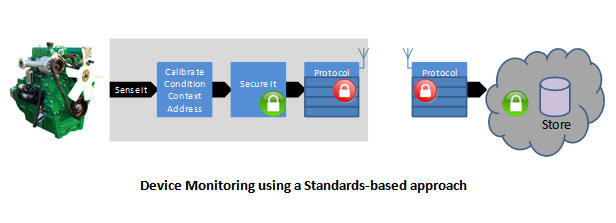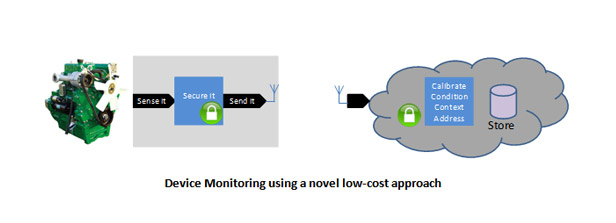How to call a tractor a tractor
The focus of standards is to define how devices connect and exchange data over a common interface. A standard defines how to connect a Thing to a network, but then what? The data still needs to be put in context, to say what its data means and to define other parameters, such as how often it should be updated and where it should send its data too. Only when all these data types and parameters are defined, agreed and standardised, from tractor to washing machine, from engine temperature to cycle-complete, is it possible to interact with a Thing in a standard way.
Bluetooth encountered this problem very early in its development and approached it through the development of profiles – standardised behaviours and instructions for all parts of a user scenario. Profiles were defined for hands-free calling, video & audio distribution, synchronisation of personal information and many more. Each profile defines the format of information, protocol sequences and the usage of physical channels. The creation of each profile takes careful discussion, development, agreement and testing.
It’s a lot of work. How then will the profiles develop for the IoT, across different physical media, different standards and a myriad of devices and applications?
Industry bodies and initiatives are already emerging to work on the problem. Today, the Open Interconnect Consortium, Google’s Thread, the Allseen Alliance and Apple with its Homekit and Healthkit, are all working on different aspects of the IoT.
The focus of this work is on devices and the data that they submit to the Internet. As long as the focus is on standardising communications then this is the right approach: standardised formats for information that’s sent over standardised links. However, the implication of this is that data needs to be formatted, conditioned and standardised at source. We are not sure this is the optimal approach for many cases because it forces resolution of the problem to the device.
There is a vision of intelligent, IP-addressable devices presenting correctly formatted information to the right place at the right time. For many devices, this is the right approach, but for others, it pushes an additional layer of formatting, configuration and options to the furthest and weakest part of the network.
Standardising data at source can mean a missed opportunity to simplify the device.
The Cloud
The cloud is an essential component of the IoT; to collect, analyse and process information. However, it is possible to take cloud processing much further than that.
TTP is now integrating the cloud into wireless systems design from the start – developing the complete system together to minimise cost, simplify installation and enable new classes of application. The methodology is very simple; by making more intelligent use of data in the cloud it is possible to further reduce the complexity at each monitoring node or Thing. At each stage of processing, innovative algorithms can be applied to reduce per-node cost and power.
The cloud can receive and store data sent intermittently, process it to remove outliers and make it available to users and other cloud services. The rationale for this remains the same – to keep the device as simple and as low power as possible. Some ways the cloud can be used to simplify Things are:
- Allowing Things to provide raw data, with context and storage resolved in the cloud.
- Resolving IP addressing in the cloud, so the device is never directly polled.
- Resolving missed/duplicated transmissions in the cloud to reduce protocol overheads.
- Using data itself to relate to where in a system a specific node is installed.
- Performing storage, translation, calibration, context, signal conditioning and presentation in the cloud to reduce processing on the device.
The cloud can play a pivotal role in keeping Things simple.
Security
Security remains critical, but the trust relationships for Things are different to that applied by most standards today. Standards-based security, such as that applied over Bluetooth or 802.11, creates a secure and trusted relationship between device and base-station or from device-to-device. For many Things however, the trust relationship is needed between the Thing and the cloud; and for standards based implementation, this often means a second layer of security.
The security requirements can be different too. Standards-based security is primarily concerned with privacy. Depending on the application, integrity of data from Things can be much more critical: knowing that the data has not been interfered with at any point on its journey from the Thing to its recipient. It’s unclear how an attacker can benefit from knowing the oil level of a combine harvester, but if the data is falsified and the oil ran out, it could cause severe impact.
A single layer of end-to-end security is much simpler and can be just as effective for Things.
Custom Radio
Using a standard is always a compromise. In return there are economies of scale and network-side benefits that can simplify the connection. So, is there a place then for a proprietary radio solution? Each application will have its own parameters of range, power and cost. If these map efficiently onto a standard, then a standards-based implementation can provide quick market access. It is important to recognise however, that there are also options available outside of this envelope and in many cases, these can lead to strongly differentiated solutions.
It is possible to combine a sweet-spot of spectrum, commodity silicon and cloud-based processing to enable exceptionally low-cost, low power and secure wireless devices. The concept is illustrated below:


By careful selection of radio technologies and by avoiding a complex protocol stack, it is possible to significantly reduce memory, processing requirements and signal processing in the radio link. The 2.4GHz ISM band is already over-used by WiFi, Bluetooth, Zigbee and your microwave oven and requires complex and careful avoidance of other users that adds complexity and power. There are better choices here too. Combining all these technologies can enable a radio bill of materials of less than a dollar and multi-year battery life for many simple monitoring devices.
It is often the case in vertical applications that both end-points of the wireless link are owned by one vendor, but simplifying the radio link means that the cost of implementing both ends can still be lower than a single standards-based end-point. Combined with diminishing returns for increased silicon integration and fit-and-forget power, custom implementations, if correctly done can drive some truly disruptive opportunities.
Moving forward, one Thing at a time
At TTP we have been quietly building the Internet of real Things and solving big challenges such as developing robust sensors to collect data, reliable and cost effective wireless technologies to deliver it and innovative cloud processing to make sense of it.
The Internet of Things represents a wide-ranging opportunity. There are a lot of suppliers, standards and technologies in a complicated market, but we believe there are still some big opportunities for companies to take on unresolved challenges in collecting measurements from Things and drive broad innovation in cloud processing.
Michael Barkway, Consultant, TTP, www.ttp.com
Michael Barkway has more than 25 years’ experience in the cellular and wireless industries, pioneering the development of one of the world’s first GSM basestation designs through very early development work on custom silicon and software for DECT, 802.11, Bluetooth, 3G, HSDPA and LTE. Michael holds an MBA from Cranfield University and a BSc in Electronics from Manchester.










